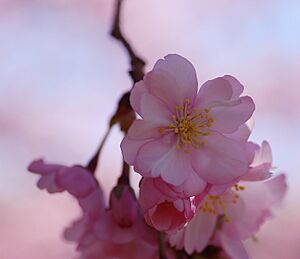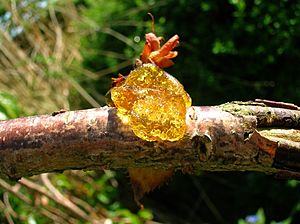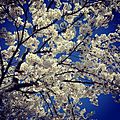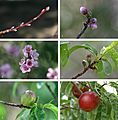Prunus facts for kids
Quick facts for kids Prunus |
|
|---|---|
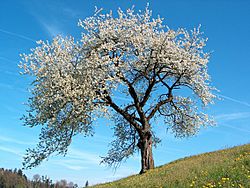 |
|
| Prunus cerasus (sour cherry) in bloom | |
| Scientific classification | |
| Kingdom: | |
| Division: | |
| Class: | |
| Order: | |
| Family: | |
| Subfamily: | |
| Genus: |
Prunus
|
| Synonyms | |
|
|
Prunus is a large group of plants. It belongs to the Rosaceae family, which also includes roses. This group is famous for its delicious fruits. It includes many popular trees and shrubs.
Some of the most well-known Prunus plants are plums, peaches, almonds, apricots, and cherries. These plants are grown all over the world. They are valued for their tasty fruits and beautiful flowers.
Contents
Health Benefits of Prunus Fruits
Eating lots of fruits is great for your health. Prunus fruits are packed with good stuff. They contain many natural compounds called phytochemicals and antioxidants. These compounds are like tiny superheroes for your body.
Eating these fruits can help protect you from different sicknesses. This includes heart problems, cancer, and diabetes. They can also help your body stay strong as you get older. Many things can change how many good compounds are in the fruits. This includes the weather, how they are grown, and how they are stored.
Cherries: Tiny Powerhouses
Cherries are full of special compounds called phenolic compounds and anthocyanins. These are what make cherries rich in antioxidants. Antioxidants help protect your body's cells from damage.
Your body naturally makes things called ROS. Too many ROS can harm your cells. This can lead to many diseases. Antioxidants in cherries help to get rid of these harmful ROS. They act like a shield for your cells. Some studies even suggest that sweet cherries might have properties that fight against tumors.
Almonds: A Healthy Snack
Like cherries, almonds are also rich in phenolic compounds. They have a high ability to absorb harmful substances in your body. This means they are packed with antioxidants.
Almonds contain special compounds called flavonoids. These are found in many plants. Flavonoids add to the antioxidant power of almonds. So, munching on almonds is a great way to get these protective compounds.
Plums: Antioxidants in the Skin
Plums are one of the best stone fruits for antioxidants. Stone fruits are fruits with a hard pit or "stone" inside. Plums have a very high total antioxidant capacity (TAC).
The skin of a plum has much more antioxidant power than the flesh. So, it's a good idea to eat the skin when you enjoy a plum!
Apricots: Full of Color and Vitamins
Apricots are rich in carotenoids. These are the natural colors that give apricots their yellow and orange look. Carotenoids are also very important for your body.
They help your eyes stay healthy and boost your immune system. This is because carotenoids are used to make vitamin A in your body. Apricots also contain other good compounds like catechin and caffeic acid.
Peaches and Nectarines: Sweet and Healthy
Peaches and nectarines are similar to plums. Their skin has more antioxidants than their juicy flesh. They also contain carotenoids, which give them their lovely orange and yellow colors.
These fruits are a good source of ascorbic acid. Vitamin C is super important for your body. It helps your body repair tissues. It also helps you absorb iron from your food.
Pests and Diseases
Prunus trees can sometimes get sick or be bothered by pests. For example, plum trees should not be planted near hop fields. This is because a tiny insect called the Damson-hop aphid likes to live on plum trees in winter. Then, it moves to hop plants and can harm them.
Sometimes, Prunus fruits can suffer from "corking." This is when the fruit tissue dries out. It often happens if the tree doesn't get enough boron or calcium.
Gummosis is another common problem for stone fruit trees. This is when a sticky, jelly-like substance leaks out of the tree's bark. It's the tree's way of reacting to an injury. This could be from insects, a cut, or a disease.
Images for kids
-
Japanese cherry (Prunus serrulata) blossoms
-
Tibetan cherry (Prunus serrula) bark
-
Black cherry (Prunus serotina) in bloom
-
The development sequence of a nectarine (P. persica) over a 7.5-month period, from bud formation in early winter to fruit ripening in midsummer
See also
 In Spanish: Prunus para niños
In Spanish: Prunus para niños


